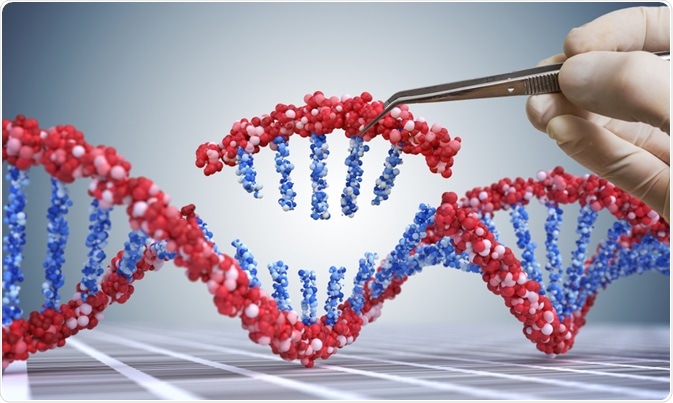Food allergies are widespread within the human population. In the western world, the proportion of people suffering from food allergies is increasing. It is estimated that 3-5% of children and 1-3% of adults suffer from some form of food allergy.
A food allergy occurs when the immune system recognizes a harmless protein as dangerous and triggers an immune response. In extreme cases, this response can be fatal with 200 people dying each year from a peanut allergy in the USA. Gene editing represents a possible method for tackling this growing problem. Gene editing can be harnessed in a variety of different ways including; identification of allergens, disease models, hypoallergenic food, or modification of the immune response.

Food Allergy. Image Credit: Evan Lorne/Shutterstock.com
Immune responses to food allergies
The immune system is very complex. Allergic reactions are caused by immunoglobin E (IgE) cells recognizing antigens in food and initiating an immune response. There are many different proteins in food, and the immune system needs only to react to one of these to cause an allergic reaction.
The immune system of two people with a food allergy may be responding to different proteins within the food. However, some proteins are more likely to be responsible for the immune response than others, these are called major allergens.
Gene editing applications in food allergies
As gene editing can modify the genetic make-up of an organism, there are serval different applications for the technique within food allergies. Firstly, the technique can be used to aid in the identification of major allergens through manipulating gene expression. It can also be used to create transgenic models to help further understand allergic reactions and through the creation of transgenic plants produce hypoallergenic foods, these have the major allergens removed or suppressed.
Alternatively, the technique could be used to manipulate the immune system, stopping the IgE cells from recognizing the allergens as harmful.
Techniques for gene editing
Gene editing can cover several techniques, all of these manipulate the genome and gene expression. The RNAi technique uses RNA to interfere with mRNA transcripts of the specifically targeted protein. The RNAi binds to this protein thus targeting it for degradation by the power Argonaute protein. A different often used technique is CRISPR, this has been described as using molecular scissors.
A gRNA (guide RNA) is responsible for targeting the gRNA/Cas complex to the desired genomic location while the nucleolytic activity of Cas (CRISPR associated) protein creates a double-strand break. The genetic editing occurs through manipulation of the cells normal double-strand break repair systems to either incorporate a new supplied gene or knockout an existing gene.

Gene Editing. Image Credit: vchal/Shutterstock.com
Gene editing in identifying the allergens
To use gene-editing techniques, the allergic response has to be understood. Take the example of the peanut, many proteins are responsible for this eliciting allergic response but the two major ones are Ara h 2 and Ara h 6.
Experiments involving the gene-editing of peanuts to reduce the expression Ara h 2 also reduced the IgE binding capacity, therefore, lessening the allergic response.
Gene editing in hypoallergenic food
The creation of foods that have reduced allergens has been accomplished by using RNAi. This technique was used in the creation of transgenic peanuts plants. They significantly reduced the expression of Ara h 2 genes, thereby the production of the Ara h 2 protein. Noticeably this reduction became more potent in successive generations as the plants became homogenous for gene editing.
However, the problem with modifying plants to produce hypoallergenic food is that it is plant-specific, only the food produced by that plant will not trigger an allergic reaction, therefore the sufferer still has to avoid all other variations of that particular food.
Gene editing in immune response
By using gene editing, the response of immune system could potentially be altered, removing the immune response and with it, the need for food allergy suffers to avoid certain foods or, in the case of hypoallergenic foods, certain strains of food. Unfortunately, there are risks associated with genetically editing the immune system, and modifying the human immune system is still a long way off but the technology is of interest.
The expression of food allergies is very complex, it involves interplay between many factors including the genes and epigenome. Being able to use the gene-editing techniques to create transgenic mice has enabled these interactions to be studied in greater depth. Alongside this, the use of the Cas9 protein without nucleolytic activity (dCas9) as a molecular scaffold to modify the epigenome has advanced understanding.
Furthermore, the safety of using Cas9 has been improved by using a combination of two Cas9 proteins that target opposite strands of the DNA reducing the chance for off-target effects. The appeal of this technology is that in the long term it has to potential to cure food allergies but extreme care must be taken to avoid unwanted side effects.
Summary
Gene editing has many varied applications including in the field of food allergies. The applications include advancing the understanding of food allergies, the production of hypoallergenic foods, and manipulating the immune system's reaction to the allergens. Progress has been made on using gene-editing techniques to understand food allergies through the identification of allergens and the creation of accurate transgenic models.
Another advancement has been the creation of hypoallergenic foods. These are foods that have been modified to reduce or eliminate the presence of allergens but the disadvantage is that all other non-modified versions would elicit an allergic reaction.
Lastly, there is the potential to modify the immune response of the individual with the food allergy thereby removing allergic reaction. However, there are multiple risk factors for this route that means it a long way from being implemented.
References
- Dodo, H. W., Konan, K. N., Chen, F. C., Egnin, M., & Viquez, O. M. (2008). Alleviating peanut allergy using genetic engineering: The silencing of the immunodominant allergen Ara h 2 leads to its significant reduction and a decrease in peanut allergenicity. Plant Biotechnology Journal, 6(2), 135–145. https://doi.org/10.1111/j.1467-7652.2007.00292.x
- Goodman, M. A., Manesh, D. M., Malik, P., & Rothenberg, M. E. (2017). CRISPR/Cas and the Future of Gene Editing in Allergic and Immunologic Diseases Michael. Expert Review of Clinical Immunology, 13(1), 5–9. https://doi.org/10.1080/1744666X.2017.1241711
- Goodman, M. A., Moradi Manesh, D., Malik, P., & Rothenberg, M. E. (2017). CRISPR/Cas9 in allergic and immunologic diseases. Expert Review of Clinical Immunology, 13(1), 5–9. https://doi.org/10.1080/1744666X.2017.1241711
- Knoll, J. E., Ramos, M. L., Zeng, Y., Holbrook, C. C., Chow, M., Chen, S., Maleki, S., Bhattacharya, A., & Ozias-Akins, P. (2011). TILLING for allergen reduction and improvement of quality traits in peanut (Arachis hypogaea L.). BMC Plant Biology, 11(1), 81. https://doi.org/10.1186/1471-2229-11-81
- Potaczek, D. P., Harb, H., Michel, S., Alhamwe, B. A., Renz, H., & Tost, J. (2017). Epigenetics and allergy: From basic mechanisms to clinical applications. Epigenomics, 9(4), 539–571. https://doi.org/10.2217/epi-2016-0162
- Zhuang, Y., & Dreskin, S. C. (2013). Redefining the major peanut allergens. Immunologic Research, 55(1–3), 125–134. https://doi.org/10.1007/s12026-012-8355-x
Further Reading